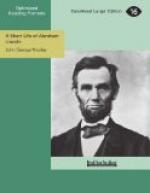It will be seen from the foregoing outline that the original hope of the Southern leaders to make the Ohio River the northern boundary of their slave empire was not realized. They indeed secured the adhesion of Virginia, North Carolina, Tennessee, and Arkansas, by which the territory of the Confederate States government was enlarged nearly one third and its population and resources nearly doubled. But the northern tier of slave States—Maryland, West Virginia, Kentucky, and Missouri—not only decidedly refused to join the rebellion, but remained true to the Union; and this reduced the contest to a trial of military strength between eleven States with 5,115,790 whites, and 3,508,131 slaves, against twenty-four States with 21,611,422 whites and 342,212 slaves, and at least a proportionate difference in all other resources of war. At the very outset the conditions were prophetic of the result.
XV
Davis’s Proclamation for Privateers—Lincoln’s Proclamation of Blockade—The Call for Three Years’ Volunteers—Southern Military Preparations—Rebel Capital Moved to Richmond—Virginia, North Carolina, Tennessee and Arkansas Admitted to Confederate States—Desertion of Army and Navy Officers—Union Troops Fortify Virginia Shore of the Potomac—Concentration at Harper’s Ferry—Concentration at Fortress Monroe and Cairo—English Neutrality—Seward’s 21st-of-May Despatch—Lincoln’s Corrections—Preliminary Skirmishes—Forward to Richmond—Plan of McDowell’s Campaign
From the slower political developments in the border slave States we must return and follow up the primary hostilities of the rebellion. The bombardment of Sumter, President Lincoln’s call for troops, the Baltimore riot, the burning of Harper’s Ferry armory and Norfolk navy-yard, and the interruption of railroad communication which, for nearly a week, isolated the capital and threatened it with siege and possible capture, fully demonstrated the beginning of serious civil war.
Jefferson Davis’s proclamation, on April 17, of intention to issue letters of marque, was met two days later by President Lincoln’s counter-proclamation instituting a blockade of the Southern ports, and declaring that privateers would be held amenable to the laws against piracy. His first call for seventy-five thousand three months’ militia was dictated as to numbers by the sudden emergency, and as to form and term of service by the provisions of the Act of 1795. It needed only a few days to show that




